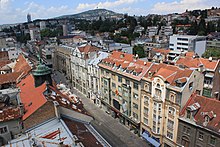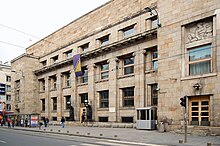
Sarajevo is the capital and largest city of Bosnia and Herzegovina, with a population of 275,524 in its administrative limits. The Sarajevo metropolitan area including Sarajevo Canton, East Sarajevo and nearby municipalities is home to 555,210 inhabitants. Located within the greater Sarajevo valley of Bosnia, it is surrounded by the Dinaric Alps and situated along the Miljacka River in the heart of the Balkans, a region of Southern Europe.

Centar is a municipality of the city of Sarajevo, Bosnia and Herzegovina. It is located between the older parts of the city under Stari Grad, and the newer more modern parts of the city under the municipalities Novi Grad and Novo Sarajevo.
Dnevni avaz is the most influential and best-selling daily newspaper in Bosnia and Herzegovina. It is published in Sarajevo. Their web portal Avaz.ba is the third most visited website in Bosnia and Herzegovina, after Google and YouTube.

Baščaršija is Sarajevo's old bazaar and the historical and cultural center of the city. Baščaršija was built in the 15th century when Isa-Beg Ishaković founded the city.
The architecture of Bosnia and Herzegovina is largely influenced by four major periods, when political and social changes determined the creation of distinct cultural and architectural habits of the region.

Grbavica Stadium is located in Grbavica, Sarajevo, Bosnia and Herzegovina. This football stadium has terraces close to the pitch and it is the home stadium of FK Željezničar Sarajevo and one of two stadiums of the national football team of Bosnia and Herzegovina. The stadium has a capacity to hold 13,146 seated spectators, with more room for standing spectators under South stands. Grbavica Stadium is also known as Dolina ćupova.

The Avaz Twist Tower is a 40 story, 172m tall skyscraper in Sarajevo, Bosnia and Herzegovina. It is the headquarters for Dnevni avaz, a Bosnian newspaper company. The tower is located in the Marijin Dvor city neighborhood, Sarajevo's central municipality. Construction began in 2006 and was finished two years later in 2008. The tower is notable for its twisted facade. From 2008 until 2021, it was the tallest skyscraper in the former Yugoslavia. In 2009, famous German company Schuco chose the tower amongst the 10 most beautiful buildings in the world.
The Oriental Institute in Sarajevo is an academic institute in Sarajevo, Bosnia and Herzegovina. It was founded in 1950 by the Socialist Republic of Bosnia and Herzegovina and is part of the University of Sarajevo. but it suffered significant destruction in 1992 during the Siege of Sarajevo.

The Eternal flame is a memorial to the military and civilian victims of the Second World War in Sarajevo, Bosnia and Herzegovina. The memorial was dedicated on 6 April 1946, the first anniversary of the liberation of Sarajevo from the four-year-long occupation by Nazi Germany and the fascist Independent State of Croatia.

Trams in Sarajevo are a part of the public transport system in Sarajevo, the capital city of Bosnia and Herzegovina. The system is run by KJKP GRAS Sarajevo, which also operates trolleybus and bus routes in the city.
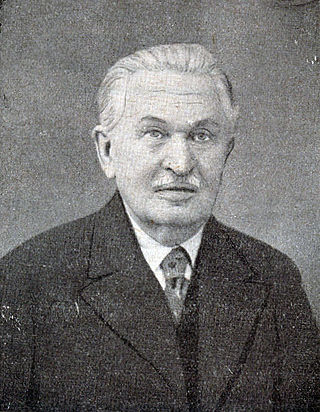
Karel Pařík was a Czech-born architect in the Austro-Hungarian empire. Pařík spent most of his life in Sarajevo where he designed over seventy major buildings, which are today classified among the most beautiful in Bosnia and Herzegovina. For Bosnians, he is also known as Karlo Paržik and is considered as "The builder of Sarajevo". He died working on his last project, Sarajevo City Hall, which later became one of the symbols of the city. "Czech by birth, Sarajevan by choice" stands encrypted on his gravestone in Sarajevo.

Marijin Dvor or Marindvor is a neighborhood in Sarajevo, Bosnia and Herzegovina.
The Bosnian Cultural Center is a national cultural center located in Sarajevo, Bosnia and Herzegovina. The center was established in 1966 and is housed in a former synagogue built in the Moorish Revival architectural style. The center is run as a public institution by the Sarajevo Canton.

Sarajevo main railway station is a railway in Sarajevo, the capital of Bosnia and Herzegovina, located in the northwest part of the city, approximately 3 kilometers from the downtown area near city part Marijin Dvor.

The Nijaz Duraković Park, formerly and also known as Hastahana, is a park located in Marijin Dvor neighborhood in Centar municipality of Sarajevo, Bosnia and Herzegovina.
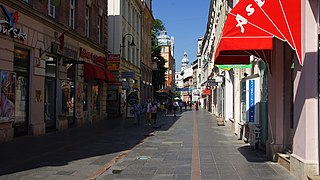
Ferhadija street is one of main pedestrian streets in Sarajevo, located in the municipalities of Centar and Stari Grad. The street is named after Ferhad-bey Vuković-Desisalić, a Bosnian sanjak-bey who lived in the 16th century.

Sarači street is one of main pedestrian streets in Sarajevo, located in Baščaršija, Stari Grad Municipality. Sarači street is named after Saraç, a Turkish word for craftsmen who are making saddles.

Trg oslobođenja - Alija Izetbegović is a square in Sarajevo, Bosnia and Herzegovina. It lies between the municipalities Stari Grad and Centar. It links the main pedestrian thoroughfare of the Sarajevo old town, Ferhadija street, with Zelenih Beretki street, with the Dom Armije (1881). On its east side it hosts the Orthodox Cathedral (1874) and the University of Sarajevo School of Economics and Business. On its west is the Svjetlost building, while at its south, beyond Zelenih Beretki, stands the Dom Armije (1881)
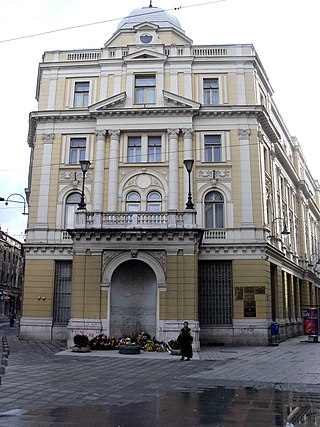
The Landesbank für Bosnien und Herzegowina was a bank established in Sarajevo in 1895 to help finance the development of Bosnia and Herzegovina under Austro-Hungarian rule. It kept operating after the establishment of the Kingdom of Yugoslavia and during World War II, but had ceased operations by 1954.
